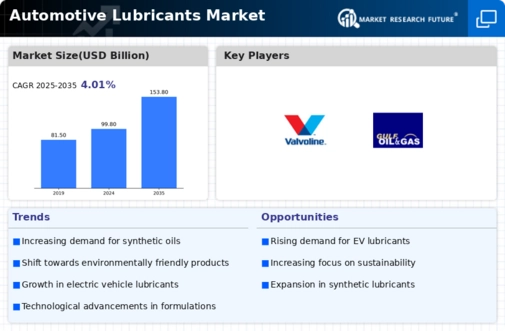Market Trends
Key Emerging Trends in the Automotive Lubricants Market
The automotive lubricants market is a dynamic sector witnessing notable trends driven by various factors. One prominent trend is the shift towards synthetic lubricants. Synthetic lubricants offer superior performance in terms of longevity, temperature resistance, and efficiency compared to conventional mineral-based oils. This shift is fueled by the automotive industry's emphasis on enhancing engine efficiency and meeting stringent emissions regulations. Additionally, the growing demand for high-performance vehicles and advanced engine technologies further propels the adoption of synthetic lubricants.
Using lubricants helps in fuel-saving and hence results in more cost savings. It helps in the reduction of emission of carbon dioxide. It also helps in improving the functioning of the machines and vehicles. It also helps in keeping the engine clean for a longer period.
Another significant trend is the increasing focus on environmental sustainability. With concerns over carbon emissions and environmental impact on the rise, automotive lubricant manufacturers are developing eco-friendly formulations. Bio-based lubricants, made from renewable sources such as vegetable oils, are gaining traction due to their biodegradability and reduced environmental footprint. Moreover, there is a growing emphasis on recycling and re-refining used lubricants to minimize waste and conserve resources.
Furthermore, the evolving automotive landscape, characterized by the rise of electric vehicles (EVs) and hybrid vehicles, is influencing the lubricants market. While traditional internal combustion engines require lubricants for smooth operation, EVs utilize electric motors that have different lubrication needs. However, ancillary components in EVs such as bearings and gears still require lubrication, albeit in smaller quantities. Consequently, lubricant manufacturers are adapting their product offerings to cater to the specific requirements of electric and hybrid vehicles.
Moreover, the automotive aftermarket segment is witnessing notable developments in the lubricants market. With an increasing number of vehicles on the road globally, the demand for aftermarket automotive lubricants remains robust. Consumers are increasingly inclined towards premium lubricants that offer better protection and performance for their vehicles. Additionally, the proliferation of e-commerce platforms has made it easier for consumers to access a wide range of lubricant products, further driving market growth.
In addition to product innovations, market players are also focusing on strategic collaborations and partnerships to expand their market presence. Joint ventures between lubricant manufacturers and automotive OEMs enable the development of tailored lubricant solutions that meet specific engine requirements. Furthermore, partnerships with distribution networks and retail outlets help lubricant companies enhance their market reach and customer engagement.
Emerging markets present significant growth opportunities for the automotive lubricants market. Rapid urbanization, increasing disposable incomes, and a burgeoning automotive industry in countries across Asia-Pacific, Latin America, and the Middle East are driving demand for lubricants. Market players are investing in expanding their manufacturing and distribution capabilities in these regions to capitalize on the growing automotive sector.
However, the automotive lubricants market also faces certain challenges. Fluctuating crude oil prices can impact the production costs of lubricant manufacturers, affecting pricing strategies and profit margins. Moreover, stringent regulations pertaining to emissions and environmental standards require lubricant companies to invest in research and development to ensure compliance with regulatory requirements.

















Leave a Comment